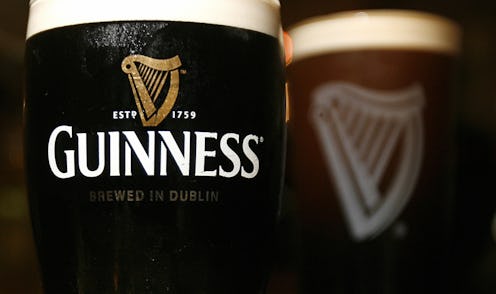I love my booze as much as the next girl, but I'm definitely guilty of not always keeping track of what I'm drinking. This little tidbit might make it easier to do so, though: Alcoholic beverages company Diageo recently announced that they'll be putting nutritional labels on all their alcohol brands worldwide “as soon as practicable.” This is either really bad news or really awesome news, depending on your perspective. Me? I'm inclined to think it's good news. Here's why.
First, let's start with the bad news: Once these labels are in place, you'll know exactly how many empty calories you're consuming when you crack open a Guinness or pour yourself a scotch, which will probably make you feel kind of guilty. Not that you should feel guilty — but let's face it: It's probably going to happen. Not having that sort of information present lets us kind of pretend it doesn't exist.
I would argue, though, that the good news outweighs the bad news. While it's true that the ingredients lists and calories-per-serving information is pretty widely available online, most of us don't usually stop and Google our vodka (or beer, or whatever) before we drink it. Nutritional labels right there on our bottles means we won't have to — which, in turns, means we'll be much more aware of what we're consuming. You know that whole thing about drinking responsibly? The labels will probably help us stick to it.
Yes, even you, Superman.
Diageo is based in London, but operates in over 180 countries worldwide. Diageo's brands include, but definitely aren't limited to: Guinness, Red Stripe, and Harp beers; Johnnie Walker scotch; Ketel One and Smirnoff vodka; Gordon's and Tanqueray gin; Captain Morgan's rum; and wines from Sterling Vineyards, Acacia, and Hewitt Vineyard. Again, though, that's just a tiny, tiny selection of the many brands that fall under the Diageo umbrella, so head on over to their website to see the full list. Said Ivan Menezes, Diageo's Chief Executive, about the choice, “Currently, there is no obligation to provide such information in markets worldwide, but we know that consumers are increasingly discerning about what's in their glass. We want to provide alcohol and nutrition information that consumers can quickly understand, instead of expecting them to do the maths.”
In the U.S., the reason alcohol isn't required to have nutrition labels is pretty simple: Booze isn't regulated by the FDA. It's regulated by the Alcohol and Tobacco Tax and Trade Bureau. And as we learned from Vox's wonderfully in-depth exploration of the issue several months ago, the rules set in place by the TTB — many of which date back to the years immediately following Prohibition, which is when the TTB was created — tend to be kind of inconsistent. Efforts to get the government to make nutrition labels for alcohol a requirement have failed time and time again, so it's kind of nice to see a company actually taking the lead themselves. Indeed, it's the first company to voluntarily do so, according to Bloomberg News.
As Cosmo notes, though, it might be a while before the labels actually start appearing; writes Elizabeth Narins, “Because the TTB needs to approve every single label for every single flavor of every single booze brand, and because it will take some time to clear the current bottles from liquor store shelves, it could be a while before you see calorie counts on Diageo-brand bottles everywhere.” It's probably also worth noting that labels might not help if you're at a bar and ordering by the drink, rather than by the bottle. Still, though — knowledge is power, right?
Images: Giphy (2)
